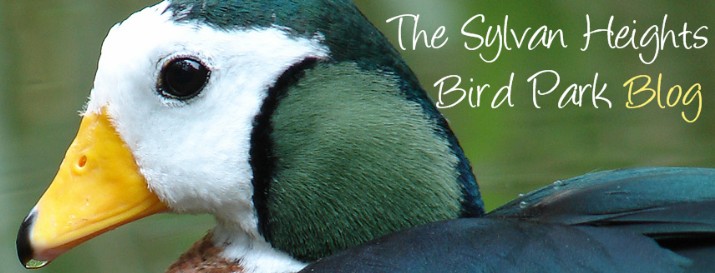Sylvan Heights is proud to introduce one of our newest additions to the Park: a young whooping crane. Only a handful of places in North America work with these birds, and the Park is the only private facility given the privelege to display this endangered species. Hatched last spring at the International Crane Foundation in Wisconsin, the young male whooping crane incurred a leg injury and was deemed non-releasable back into the wild. Sylvan Heights is thrilled to be given the opportunity to use this bird as an animal ambassador to educate the public about the plight and resulting programs successfully created for this species.
The rarest of the 15 crane species, whooping cranes are native to North America. In 1941, a bird count revealed that only 16 living birds were left in the wild. Since then, extraordinary conservation efforts have been made, the result of which is that we now have just over 500 birds in the world.
The tallest bird in North America, an adult whooping crane is imposing. They stand between 4 and 5 feet high, with snowy white plumage, except for a brilliant red cap on the top of their heads, and black facial markings and black primary feathers clearly visible in flight. Their long, spear-like beaks and fierce golden eyes make an adult whooping crane quite formidable when protecting its young.
They get their name from their distinctive "whoop-like" call, which pairs often make in unison. Whoopers are gregarious by nature meaning that they prefer to live in a group, or in their case, family groups. They frequent marshes, shallow lakes and lagoons where there is an abundance of aquatic vertebrates and invertebrates for their young to feed on. Sometimes adults may kill larger prey such as rodents, snakes and small birds.
In the wild, whooping cranes naturally migrate 4000 km from their breeding grounds in Canada's Wood Buffalo National Park to their wintering grounds at the Aransas National Wildlife Refuge in Texas.
However, scientists became concerned of the potential risk associated with having only one wild population of whoopers. They recognized that the group could easily be wiped out by disease, bad weather or other factors.
So a successful captive rearing and reintroduction program using ultralight airplanes was implemented. It focuses on raising the chicks of captive pairs and "guiding" them on their first migration southward. Operation Migration has been remarkably successful in its goal to establish an eastern population of migrating whoopers. Each fall, a team of dedicated conservationists, guide a group of young birds from Wisconsin south to Florida.
But OM also works with other species including sandhill cranes and Canada geese. To learn more about their programs, please visit their comprehensive web site. It includes a great deal of information on everything from the natural history of the birds themselves, to video clips about training the young birds to follow the ultralights, to audio bites of vocalizations, and much, much more.

